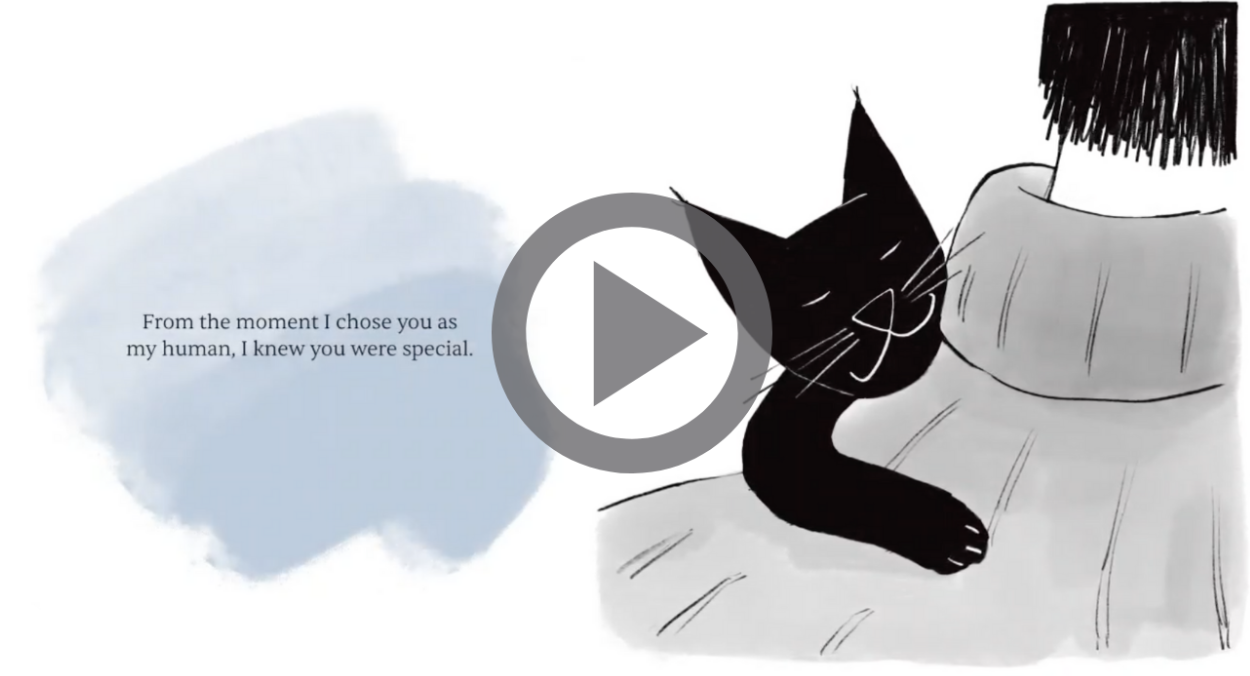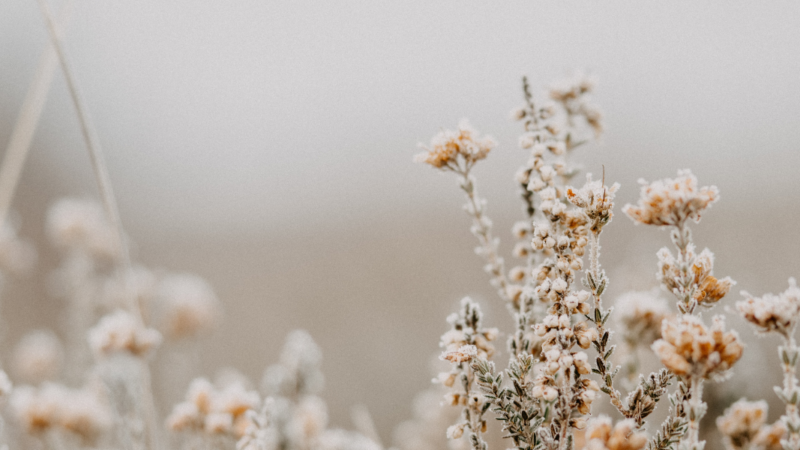An Evening with Pema Chödrön and k.d. lang
Bestselling author and beloved meditation teacher Pema Chödrön has touched the lives of millions with her down-to-earth guidance for becoming happier, “saner” people in an ever-changing and challenging world. Grammy®-winning recording artist and Buddhist practitioner k.d. lang has likewise been a source of inspiration worldwide through her music, songwriting, and soaring vocals.
Learn more and purchase tickets here!
An Evening with Pema Chödrön and k.d. lang is a once-in-a-lifetime opportunity to join these two extraordinary women who are both uniquely gifted “instruments of the dharma,” helping us to soften and open our hearts. Moderated by Sounds True publisher and founder Tami Simon, this night of discovery and insight will support both The Pema Chödrön Foundation and Tools for Peace.
Our evening will begin with a dialogue with Pema Chödrön, who will share her insights into life’s “big questions”—including how we can begin to face uncertainty and engage the unknown—along with practical guidance in becoming more vulnerable, authentic, and present with ourselves and with each other. Then k.d. lang will join the conversation, speaking about her personal approach to creativity and the roles that trust, devotion, and surrender play in that process, the surprising parallels between the journeys of the artist and the meditator, and more.
Our evening concludes with a special musical performance by k.d. lang, who will offer a selection of songs with a piano accompaniment, buoyed by the incredible acoustics of Royce Hall.
Learn more and purchase tickets here!

Tracing the Roots of Your Attachment Style

Let’s face it: life is sometimes quite hard. It doesn’t matter who you are; all of us inevitably bump into challenges and hardships that are beyond our control. If you’re on this planet long enough, you’re going to be hit with some form of misattunement or loss or abuse or divorce or disease or a car accident or an environmental disaster or war or who knows what. Sometimes these events are so overwhelming that we don’t even have the capacity to react or respond to them. You can’t stop these things from happening; they’re just part of what it means to be human. And to make matters even trickier, epigenetic studies now suggest that—in a manner of speaking—we may inherit the struggles of our ancestors. In one way or another, we’re affected by everything that our grandparents, great-grandparents, and so on went through and suffered from. But we’re also the products of their resiliency. Throughout time and our evolution as a species, people have been experiencing hardships and doing their best to endure and survive them.
So, life is hard, and it isn’t your fault. That’s just the way it is, which means that you can stop blaming yourself as if you alone are responsible. There are countless ways for any of us to end up experiencing trauma, and most of them have nothing to do with how we live our life or what kind of person we are. That’s the bad news.
But there’s good news, too.
We can do something about it.
We’re all born with an amazing capacity to survive, heal, and thrive, which is precisely the reason we’ve made it this far to begin with. It’s what we’re built for.
Before we go on, I want to be clear about what I mean when I say the word trauma. Without getting too technical, trauma is what results from experiencing an event over which you have little control; sometimes—as in the case with major accidents—you don’t even have time to brace yourself for the impact. These events overwhelm your ability to function normally, and this can make you lose trust in your feelings, thoughts, and even your body. In this way, trauma is a form of tremendous fear, loss of control, and profound helplessness.
I’ve also started thinking of trauma in terms of connection. The theme of broken connection has come up in my work repeatedly over the years: broken connection to our body; broken connection to our sense of self; broken connection to others, especially those we love; broken connection to feeling centered or grounded on the planet; broken connection to God, Source, Life Force, well-being, or however we might describe or relate to our inherent sense of spirituality, open-hearted awareness, and beingness. This theme has been so prominent in my work that broken connection and trauma have become almost synonymous to me.
When trauma hits us or we’ve experienced a lot of relational wounding, we can feel like we’re utterly disconnected—like we’re a tiny little me who’s isolated and all alone, as if we’re in our own little bubble floating around in a sea of distress, cut off from everyone and everything. I think it’s our work to pop that imaginary bubble, or at least to build bridges that connect us to others we care about. Unresolved trauma, in my opinion, has led to a nationwide epidemic of loneliness and hurt. And it isn’t just in our country. The evidence of this type of pain worldwide is readily available any time you turn on the news. That’s not the whole story, fortunately. We can heal and change. All of us are capable of healing and repairing these severed connections: to ourself, other people, the planet, and whatever it is that holds it all together.
But we can’t do it alone.
First of all, we not capable of healing in isolation. We need other people. Stan Tatkin, clinical psychologist, author, speaker, and developer of A Psychobiological Approach to Couple Therapy (PACT) along with his wife, Tracey Boldemann-Tatkin, says that we are hurt in relationship and we heal in relationship. The presence of those close to us makes a difference even in the most dire circumstances. Just to mention one study among thousands, a hospital in Illinois recently demonstrated that coma patients recovered more quickly when they were able to hear the voices of their family members.
Like it or not, we’re all on this crazy and amazing human journey together.
We can never be completely safe, but we can move toward relative safety in life and in our relationships. We will never have our needs met perfectly, and we will never be (nor have) the perfect parent. Thankfully, that’s not required for deep and lasting healing. As we grow out of our wounded self and become a more securely attached, resilient being, we can foster the same process in others, becoming intimacy initiators and connection coaches for our families, friends, and the larger world.
Let’s take a look at both sides of our parents’ behavior. Each of us is a work in progress, and I’m sure your parents had some unfinished business along with their more admirable qualities. You may find this exercise helpful in taking a deeper look into what was problematic and painful as well as the gifts your family bestowed. So often our memories of difficult times overshadow the benefits we may have gained, so this exercise is aimed at helping us see more of the whole picture—to acknowledge and grieve wounds as well as celebrate wisdom gained. Of course, often we gain wisdom and compassion from healing our wounds as well.
EXERCISE: Perfectly Imperfect
Part One—What Was Missing or Hurtful?
You may want to start this exercise by making a list of the shortcomings or failings of each of your parents—those circumstances or behaviors that had the most negative influence on you as a child. What happened is significant, and how you internalized it is even more so. Sometimes it’s easier to recount our parents’ negative attributes than it is to remember any of their positive ones, especially for those of us with an ambivalent or disorganized attachment style. Our negative experiences may overshadow the everyday neutral or basically good experiences we may have had until we regain a sense of them after healing many early wounds. People with the avoidant attachment style tend to see their histories as mostly fine, until feelings of longing resurface and they realize what they missed relationally.
Part Two—What Was Beneficial or Supportive?
My mother was a tough teacher. She lived with unresolved emotional distress, but she was also fun-loving and generous. Despite sometimes being a less-than-ideal parent, she had her own ways of expressing her love to me with special celebrations, generous gift-giving, helping me with projects close to my heart, and shopping for fun bargains we called “treasure hunting.” My father was similarly complex: he was out of touch with his emotional self and gone a lot for his work, yet he was able to convey his love quietly in a steadfast way through providing for the family, locking the doors at night, fixing my bike, teaching me to water ski, and grilling great food for picnics. He also had the core value of volunteerism that survives in our family to this day. Both of my parents did the best they could under the circumstances, and together they taught us important core values.
Try looking at each of your parents through the lens of how they may have shown you their love. Write down all the ways you have learned important lessons, skills, and insights from your most important caregivers. It can help to describe your mother and father on their best days. As best you can, give them the benefit of the doubt and consider that they were doing the very best they could with whatever level of unresolved trauma or attachment injury they lived with, as well as with whatever resources, education, and healing strategies they had available to them at that time. See if you can detect their deep care amid their imperfections and harming behaviors, no matter how murky or inarticulate they were in expressing that love for you. What do you find?
This is an excerpt from The Power of Attachment: How to Create Deep and Lasting Intimate Relationships by Diane Poole Heller, PhD.
 Diane Poole Heller, Ph.D., is an established expert in the field of Child and Adult Attachment Theory and Models, trauma resolution, and integrative healing techniques. Diane developed her own signature series on Adult Attachment called DARe (Dynamic Attachment Re-patterning experience) also known as SATe (Somatic Attachment Training experience). Dr. Heller began her work with Dr. Peter Levine, founder of SETI (Somatic Experiencing® Trauma Institute) in 1989. As Senior Faculty for SETI, she taught Somatic Experiencing® trauma work internationally for over 25 years. As a dynamic speaker and teacher, Diane has been featured at prestigious international events and conferences. She is the author of numerous articles in the field.
Diane Poole Heller, Ph.D., is an established expert in the field of Child and Adult Attachment Theory and Models, trauma resolution, and integrative healing techniques. Diane developed her own signature series on Adult Attachment called DARe (Dynamic Attachment Re-patterning experience) also known as SATe (Somatic Attachment Training experience). Dr. Heller began her work with Dr. Peter Levine, founder of SETI (Somatic Experiencing® Trauma Institute) in 1989. As Senior Faculty for SETI, she taught Somatic Experiencing® trauma work internationally for over 25 years. As a dynamic speaker and teacher, Diane has been featured at prestigious international events and conferences. She is the author of numerous articles in the field.
Her book Crash Course, on auto accident trauma resolution, is used worldwide as a resource for healing a variety of overwhelming life events. Her film, Surviving Columbine, produced with Cherokee Studios, aired on CNN and supported community healing in the aftermath of the school shootings. Sounds True recently published Dr. Heller’s audiobook Healing Your Attachment Wounds: How to Create Deep and Lasting Relationships, and her book, The Power of Attachment: How to Create Deep and Lasting Intimate Relationships.
As a developer of DARe and president of Trauma Solutions, a psychotherapy training organization, Dr. Heller supports the helping community through an array of specialized topics. She maintains a limited private practice in Louisville, Colorado.
Buy your copy of The Power of Attachment at your favorite bookseller!
A Personal Message from Ram Dass and Mirabai Bush

Dying is the most important thing you do in your life. It’s the great frontier for every one of us. And loving is the art of living as a preparation for dying. Allowing ourselves to dissolve into the ocean of love is not just about leaving this body; it is also the route to Oneness and unity with our own inner being, the soul, while we are still here. If you know how to live and to love, you know how to die.
In this book, I talk about what I am learning about death and dying from others and from my getting closer to it. And I talk about what I have learned from being at the bedsides of friends who have died, including how to grieve and how to plan for your own death as a spiritual ceremony. I talk about our fear of death and ways to go beyond that fear so we can be identified with our spiritual selves and live more meaningful lives.
I invited my friend Mirabai Bush into a series of conversations. Mirabai and I share the bond of being together with our guru, Neem Karoli Baba, and over the years, we have taught and traveled and written together. I thought she’d be able to frame the conversations for you, the reader, and also draw in some of what I’ve said in the past about dying, while keeping my current words fresh and immediate. And I wanted to discuss her thoughts on dying as well.
From Mirabai Bush . . .
This is a book about loving and dying and friendship. It is a conversation between old friends, in which we talk about love and death in an intimate setting. I hope we’ve captured Ram Dass’s wisdom, expressed in a new way now that he is 86 and close to death himself.
“It’s about sadhana, spiritual practice, and I want both our voices to be in it,” he said. “I want it to be a conversation.”
“But I need to ask a basic question,” I said.
He nodded.
“Why are we writing this? Who are we writing it for?”
“I want to help readers get rid of their fear of death,” he answered. “So they can be,” a long pause, “identified with their spiritual selves and be ready to die. If you know how to live, you know how to die. This will be a link between my teachings about Maharaj-ji and about death. And people who are living who can see that they are dying each day, that each day is change and dying is the biggest change—it could help them live more meaningful lives.”
After a while, Ram Dass continued, “I’m also thinking about people whose loved one has died, who may live with grief, or guilt and regret, and I’m thinking about those beings who are sitting bedside with the dying . . . this could help them prepare for that role. And people who are dying, who could read this book to help prepare them for dying more consciously, more peacefully, being in the moment.”
Okay, I thought. This will be a good book to write. We’ll be exploring the edge of what we know.
From Ram Dass . . .
I have had aphasia since my stroke 20 years ago. Aphasia impairs a person’s ability to process language but does not affect intelligence. Sometimes I pause for long periods to find a word or figure out how to express a thought in just the right way. I like to say that the stroke gave me the gift of silence.
When I thought about the best way to write a book on dying while having aphasia, I knew it would be important to express these ideas and experiences clearly, subtly, truthfully. I realized that these days I have been expressing what I know best when I am in dialogue with another person—someone who is comfortable with silence and listens for new ideas as they arise. Why not create a book that way?
I like that this format for the book draws you into the room with us, into this conversation that we all need to have. I invite you to watch this video of us talking together, to give you a sense of how our conversations unfolded.
https://youtube.com/watch?v=3Tq7kLnYqIs%3Fautoplay%3D1%26utm_source%3Dbronto%26utm_medium%3Demail%26utm_campaign%3DR180831-Dass-Bush%26utm_content%3DA%2BPersonal%2BMessage%2Bfrom%2BRam%2BDass%2Band%2BMirabai%2BBush
With love,
Ram Dass and Mirabai Bush
Being Witnessed In Grief Is A Powerful Balm For Healing
Dear friends,
Two days after my cat, Hedda, died in 2016, my friend Francis sent me a sketch with a note “from” Hedda that read, in part, “P.S. I love you more than tuna.” Through my tears, I thought that would be a great book title. I had a clear vision: an illustrated gift book that people would give to friends, family, colleagues, or clients after the loss of their cat. A step beyond a sympathy card, this would be the first “empathy book” for adults grieving the loss of a cat.
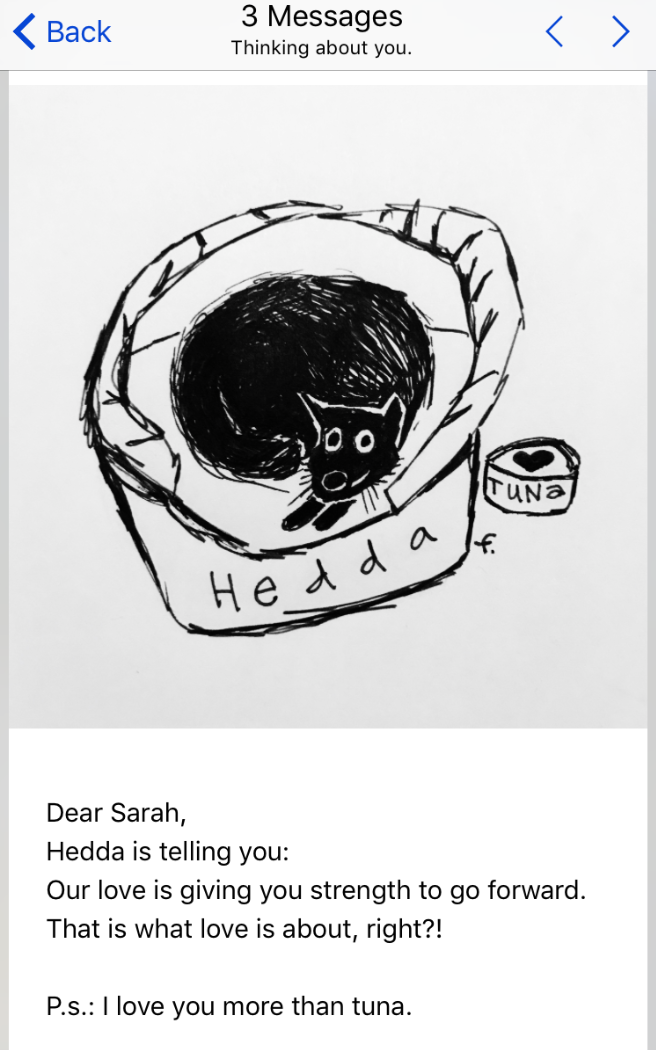
Inspired in part by Eckhart Tolle and Patrick McDonnell’s Guardians of Being and Charles M. Schultz’s Happiness is a Warm Puppy, P.S. I Love You More Than Tuna offers comfort and inspiration through New Yorker-style drawings and simple, evocative language. My goal was to make it heartfelt without being cloying.
Every year, six million Americans and Canadians must say a final goodbye to their cats—buddies who leapt into their hearts as kittens, purred away heartbreak through multiple breakups, snuggled by their side in homes large and small, and occasionally deleted folders of work by stretching out on a warm keyboard.
“Pet loss” is considered a disenfranchised form of grief; it’s not culturally sanctioned. We don’t have any universal rituals for this grief, like sitting shiva or holding a wake. This often leaves the bereaved feeling isolated and misunderstood, which compounds the grief and makes healing more difficult.
People grieving companion animals have a need to be seen, their grief validated. Being witnessed in grief is a powerful balm for healing.
Friends of those grieving companion animals are often at a loss for ways to show their support. P.S. I Love You More Than Tuna gives all of us the opportunity to make a profound impact with a simple gesture.
When Francis sent me the sketch and note, I felt seen. Francis’s gift acknowledged the bond I’d had with Hedda and my grief at her death. The present tense of the note also reminded me that Hedda was still with me, even if I couldn’t see her. That was significant in terms of helping me heal, and that’s the comfort I hope P.S. I Love You More Than Tuna will provide to other cat lovers.
Sounds True has created a lovely video preview for P.S. I Love You More Than Tuna. I hope you’ll check it out below.
Ultimately, I hope this book will benefit the world in multiple ways: for the recipient, witnessing and healing; for the giver, a tangible action they can take to help another; for Best Friends Animal Society, to which I’m donating 10 percent of my proceeds, contributing to their work of keeping pets in the home. This includes helping low-income people connect with resources they need to feed, train, and care for their companion animals. And of course, I hope this will benefit Sounds True and their work in the world, which is quickly becoming more needed than ever.
Take care,
Sarah Chauncey
The Importance of Being Vulnerable
Emotions are the primary way we connect with others. In fact, for all the ways we perceive that sharing our emotions causes trouble, it’s actually worse for us not to. Sharing our truest, most vulnerable selves actually prevents us from the isolation that occurs when we miss out on the deep connection that only comes from this type of transparency. While social media can be a place of great support, it’s also caused a huge challenge. Because we’ve created a world in which we are addicted to showing our curated emotions, social media posts rarely tell the entire story. We’ve gotten accustomed to holding back our real selves—so much, in fact, that we have a totally distorted view of what’s “real.”
On a wet fall day as I was researching the negative effects of social media for this book, I noticed that a heavy sense of melancholy had fallen over me. Pushing myself to go out for a short walk in my beloved Central Park, only a block away, took every ounce of energy I had. When I was out, my sadness didn’t fade, but astounded by the colorful change of leaves, I felt inspired to take a handful of photos. They were the kind that Instagram is made of. When I got home, I decided to post them on social media. But earlier that day I had read something that was still with me: what happened when Tracy Clayton, host of the BuzzFeed podcast Another Round, asked people to repost photos they’d previously shared on social media, but this time, with the “real story” behind them. The photos that most of us would have longed for had painful stories behind them. One woman admitted to a terrible anxiety attack that took her all day to overcome, someone else shared the grief over a loss of a loved one stuffed under their smile at a party, and so on. What this shows us is that we are all running after a farce. But what’s worse, it shows that we’re all co-creating it.
So after a brief pause, I posted my gorgeous fall photos from the park with this: Full disclosure: Inspired by research for my next book about how social media posts screw us up by making everything and everyone seem OK even when they are not, I’m adding the truth here. These pictures were taken on a walk I dragged myself on because I felt sad today for no particular reason (except for that life is a lot sometimes).
I am typically not a sad person, nor am I one who shares it on social media when I am. I am very transparent on my author account, but for some reason, I am less so on my personal page. The response that day when I shared how I really felt took me by great surprise. Dozens of people I rarely heard from came out of the blue with comments, texts, and private messages. And what most of them were saying was, “I feel that way too.” In our technological age, we are more connected than ever before, but also lonelier and more isolated than ever before. I wondered that day, What if everyone stopped staying so busy pretending everything was perfect? What if instead of hiding our vulnerabilities to prevent the isolation we fear, we are driving it?
The bottom line is that, over and over again, I’ve learned that emotions are better in every way when they aren’t kept inside and to myself.
This is an excerpt from How to Heal Yourself From Depression When No One Else Can: A Self-Guided Program to Stop Feeling Like Sh*t by Amy B. Scher.
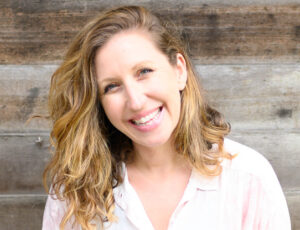 Amy B. Scher is an energy therapist, expert in mind-body healing, and the bestselling author of How to Heal Yourself When No One Else Can and How to Heal Yourself from Anxiety When No One Else Can. She has been featured in the Times of India, CNN, HuffPost, CBS, the Washington Post, Cosmopolitan, the Los Angeles Review of Books, Curve magazine, and San Francisco Book Review. Scher was also named one of the Advocate’s “40 Under 40.” She lives in New York City. For more, visit amybscher.com.
Amy B. Scher is an energy therapist, expert in mind-body healing, and the bestselling author of How to Heal Yourself When No One Else Can and How to Heal Yourself from Anxiety When No One Else Can. She has been featured in the Times of India, CNN, HuffPost, CBS, the Washington Post, Cosmopolitan, the Los Angeles Review of Books, Curve magazine, and San Francisco Book Review. Scher was also named one of the Advocate’s “40 Under 40.” She lives in New York City. For more, visit amybscher.com.
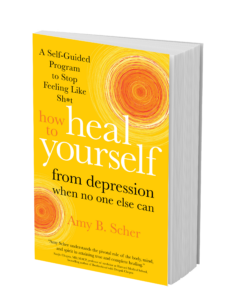
Learn More
Sounds True | Amazon | Barnes & Noble | Indiebound | Bookshop
Our Journey into Deeper Mystery – with James Hollis
James Hollis, PhD, is a graduate of Zürich’s Jung Institute, a licensed Jungian analyst practicing in Houston, Texas, and author of 13 books, including Finding Meaning in the Second Half of Life and What Matters Most: Living a More Considered Life and the Sounds True audio learning program Through the Dark Wood: Finding Meaning in the Second Half of Life.
Here, Dr. Hollis invites us to discern directly what a “spiritual life” is for us personally, opening ourselves to the mystery of our time here as a human being. At the end of our life, shares Hollis, we want to be able to say we’ve been here, that it mattered, that we lived our journey and not someone else’s, and that we’ve touched the deepest part of who we are.



